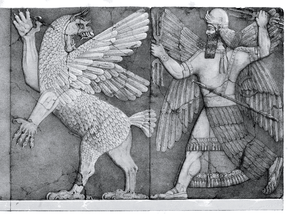Nuska
Nuska (Assyrian: dnusku, also dEn-Šadibdib or dUmun-Šazedib) was the vizier of the chief Sumerian god Enlil.[1] He is also described as a scribe who records events, and a boatman who takes Enlil to his future wife, Ninlil. His shrine was recorded to be in the Ekur.[1]
| Nuska | |
|---|---|
Vizier and scribe to the chief god Enlil, later god of fire and light, earth, and the arts | |
 | |
| Parents | Usually Anu and Antu, but sometimes Enlil and an unknown mother or Sin and Ningal |
| Equivalents | |
| Babylonian equivalent | Nusku |
| Part of a series on |
| Ancient Mesopotamian religion |
|---|
 Chaos Monster and Sun God |
|
Seven gods who decree
|
|
Other major deities |
|
Demigods and heroes
|
| Related topics |
Later, In Babylonia and Assyria, he became the light and fire god, indistinguishable from Girru (formerly Gibil).
Later influence

In Babylonia and Assyria Nuska is the symbol of the heavenly as well as of the terrestrial fire. As the former he is the son of Anu, the god of heaven, but he is likewise associated with Enlil of Nippur as the god of the earth and regarded as a first-born son. A centre of his cult in Assyria was in Harran, where, because of the predominance of the moon-cult, he is viewed as the son of the moongod Sin and his wife Ningal, though Nuska was with Enlil when Sin wasn't born yet, and Enlil hadn't married Ninlil—Sin's mother. Nuska is by the side of Ea, the god of water, the great purifier. It is he, therefore, who is called upon to cleanse the sick and suffering from disease, which, induced by the demons, was looked upon as a species of impurity affecting the body.
The fire-god is also viewed as the patron of the arts and the god of civilization in general, because of the natural association of all human progress with the discovery and use of fire. As among other nations, the fire-god was in the third instance looked upon as the protector of the family. He becomes the mediator between humanity and the gods, since it is through the fire on the altar that the offering is brought into the presence of the gods.
While temples and sanctuaries to Nusku-Girru are found in Babylonia and Assyria, he is worshipped more in symbolical form than the other gods.
For the very reason that his presence is common and universal he is not localized to the same extent as his fellow deities, and, while always enumerated in a list of the great gods, his place in the systematized pantheon is more or less vague. The conceptions connected with Nuska are of distinctly popular origin, as is shown by his prominence in incantations, which represent the popular element in the cult, and it is significant that in the astro-theological system of the Assyrian and Babylonian priests Nusku-Girru is not assigned to any particular place in the heavens.
Nusku is revered in the name of Mutakkil-Nusku ("he whom Nusku endows with confidence,") a 12th-century BC king of Assyria.
See also
Notes and references
Notes

References
- Michael V. Fox (1988). Temple in society. Eisenbrauns. pp. 8–. ISBN 978-0-931464-38-6. Retrieved 8 June 2011.